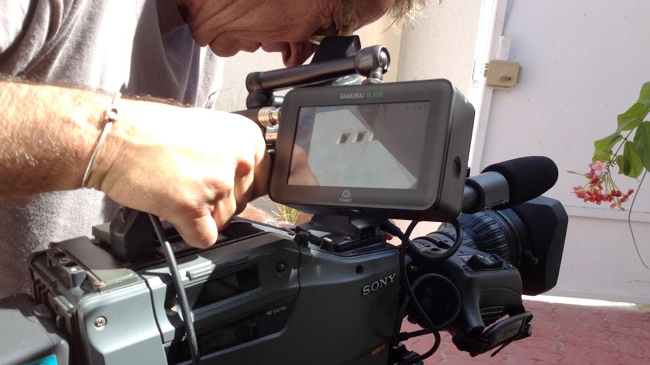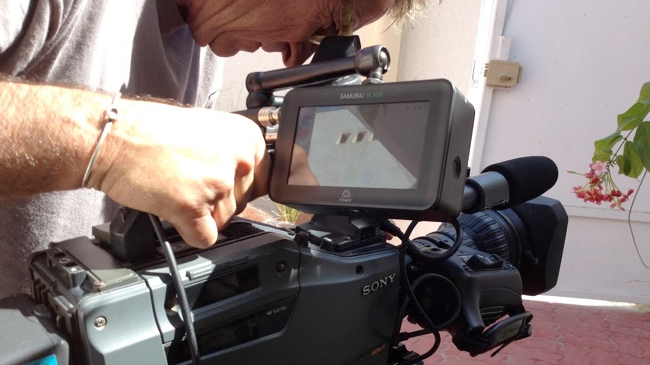
 How to Rejuvenate an old HD Camera
How to Rejuvenate an old HD Camera
Did you know you can convert older tape-based HD cameras to a file-based recording system, very easily?
It's tempting to generalise and say that the quality of video cameras just gets better and better. It's true, of course: we have 4K cameras, large sensors and raw video. But in another way, that's not completely fair to the marvellous cameras that have been around for the best part of a decade.
Tape Recording on the HDW-750P
Take the HDW-750P for example. Introduced around ten years ago, it shot progressive or interlaced 1080 video at 25 frames per second (in Europe). And it recorded directly to... tape.
To anyone that remembers the 1960s the idea that you can record video without tape still seems amazing. That you can record it now to solid state memory just seems incredible. It's very easy to loose perspective when you look at recent developments. Just twelve years ago, it was hard enough to store more than a few tracks of mp3 audio onto a flash memory, never mind a whole feature film recorded in uncompressed 4K (well, actually, that would still be difficult, but, nevertheless, 4K uncompressed recording is a workflow that's in use on film sets today).
When it came out, the HDW-750P seemed pretty state of the art. The pictures were very good. And the technology was pretty familiar. People were used to working with tape, and HDCAM was similar enough to Digital Betacam that there were few issues with handling it.
The data rate wasn't all that high either, by today's standards, and although the compression could be a bit noisy, it was robust. What it didn't do was record at the full resolution of the sensor. Video recorded to HDCAM cape is down sampled to 1440 x 1080 resulting in rectangular pixels. The final bitrate is 144 Mbit/s, although most people using tape at the time weren't concerned with data rates at all: tape is tape!
So these very well made HD cameras never had a chance to display the full quality of their output. Despite having great sensors and usually being fitted with very good glass, they weren't able to display their true greatness.
Times Have Changed
But now, all that's changed. With exactly the same camera, but with a much simpler workflow, and with very much cheaper ancillary equipment, you can get significantly higher quality from these cameras that might otherwise have been consigned to oblivion.
When external recorders came out, they had a very different target audience than owners of expensive but old broadcast cameras. The first recorders were designed to work with file-based cameras whose bitrates were restricted by the Long GOP compression they were forced to use so that they could cram HD material into the tiny and expensive flash storage that was available then. Let's be clear about this: what they achieved with bitrates of between 25 and 35 Mbit/s was actually very good. It's just that it wasn't perceived as being as good as it could be, especially by broadcasters, who fairly quickly declared that they wanted to see at least 50 Mbit/s for Long GOP recordings.
The other focus for early external recorders was HDSLR cameras. These quickly because the "go-to" device for Pro-level shooting once film makers realised that you could get cinematic-looking footage from them, albeit with all sorts of ergonomic and technical disadvantages, not least, again, low bitrates.
But the field recorder manufacturers were frustrated by HDSLRs because they would not give up their video to external devices easily. Annoyingly, the camera makers always seemed to superimpose the information normally restricted to the viewfinder on the HDMI output feed. You'd get your recording modes, autofocus points and ASA numbers splattered all over your images, and there was nothing you could do about it. In addition, many of the cameras outputted slightly non-standard video, including, but not limited to, strange pulldown cadences, non-standard aspect ratios, and desaturated video.
The situation with HDSLRs has improved a lot, and, meanwhile, professional video cameras have upped their recording bitrates, but most still benefit from external recording, not least for the increase in recording time, and, still, from a somewhat more marginal gain in quality.
Typical External Recorders
Let's just pause for a minute and look at what you get with a typical external recorder - because it's very easy to forget exactly what these things actually have to accomplish.
What comes out of the camera is uncompressed video. Neither HDMI nor SDI carry compressed video. These connections carry full-strength, full-bandwidth video that's as good as the camera can make it (with the exception of raw). Absolutely any compression at this point will reduce the quality of the signal.
Since this uncompressed video bypasses the camera's onboard compression, any compression you apply to the signal that is less severe will result in a better recorded picture than the camera could offer. This is the basic premise of field recorders.
It's worth noting that the sort of quality we're talking about here is greater than HDCAM. In a battery powered unit that you can fit in the palm of your hand. That's how far we've come in the last ten years.
Once the signal reaches the external recorder, it is compressed into an "edit-friendly" format such as ProRes or DNxHD. These are the "house" formats of Apple and Avid, and they both do essentially the same thing: they compress the video mildly instead of severely (by which we mean around 6:1 as opposed to maybe 50:1). The bitrates - potentially around 220 Mbit/s are significantly higher, but, then, so is the capacity of the storage media.
Not only can most field recorders work with SSDs - which typically have a much larger capacity than CF or SD cards, but the Atomos products can even record directly to spinning disks. Per Gigabyte, external recorders are much cheaper, and they allow you to record directly to the format you're probably going to edit with as well.
A new Back-end for your Camera
Probably the best way to think of field or external recorders is as "a new back-end for your camera".
This being the case, if you have an older HD camera that's still working fine, you can catapult it into the era of file-based recording simply by plugging the HD-SDI output into an external recorder.
I use the term "catapult" advisedly, because with an external recorder attached to your vintage camera, you can probably beat the quality of many modern file-based camera systems, because you'll be recording to a long-GOP format, with a pretty high bitrate - typically around 220 megabits per second, or less if you don't mind a slight drop in quality.
You can take your footage and drop it directly into your editor's timeline. It's a remarkable transformation: for a start you don't need an HDCAM deck. They used to cost around $50,000! For around a fiftieth of that, you can have a device that does more (you can use it as a viewfinder, for a start!) and which doesn't need rewinding. In fact, there is no capture process at all. Compared to the days of tape, it's pretty revolutionary.
Things are going to get a little more confusing with raw video cameras and the multitude of workflows that these are spawning, but remember, with codecs like ProRes, they're 10 bit, which means that although they can't improve the quality of your source video (except in comparison to encoding with lower-quality codecs) the extra levels that the 10 bits give you compared to 8 bits will allow subtler changes in grading. It's well worth the upgrade.
Peter Davies (pictured above), a Dubai-based freelance camera operator and DOP, says that using an external recorder has transformed his work, and his older camera.
Thanks to Peter for his feedback, and to Digital Broadcast Solutions LLC for supplying the Atomos field recorder.
Tags: Technology


Comments